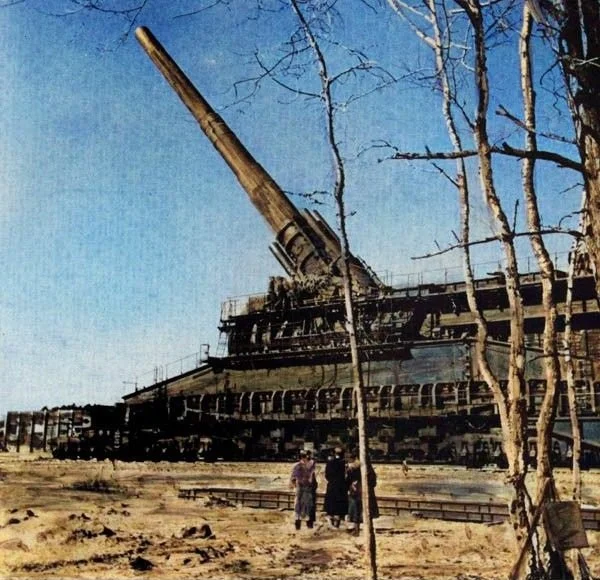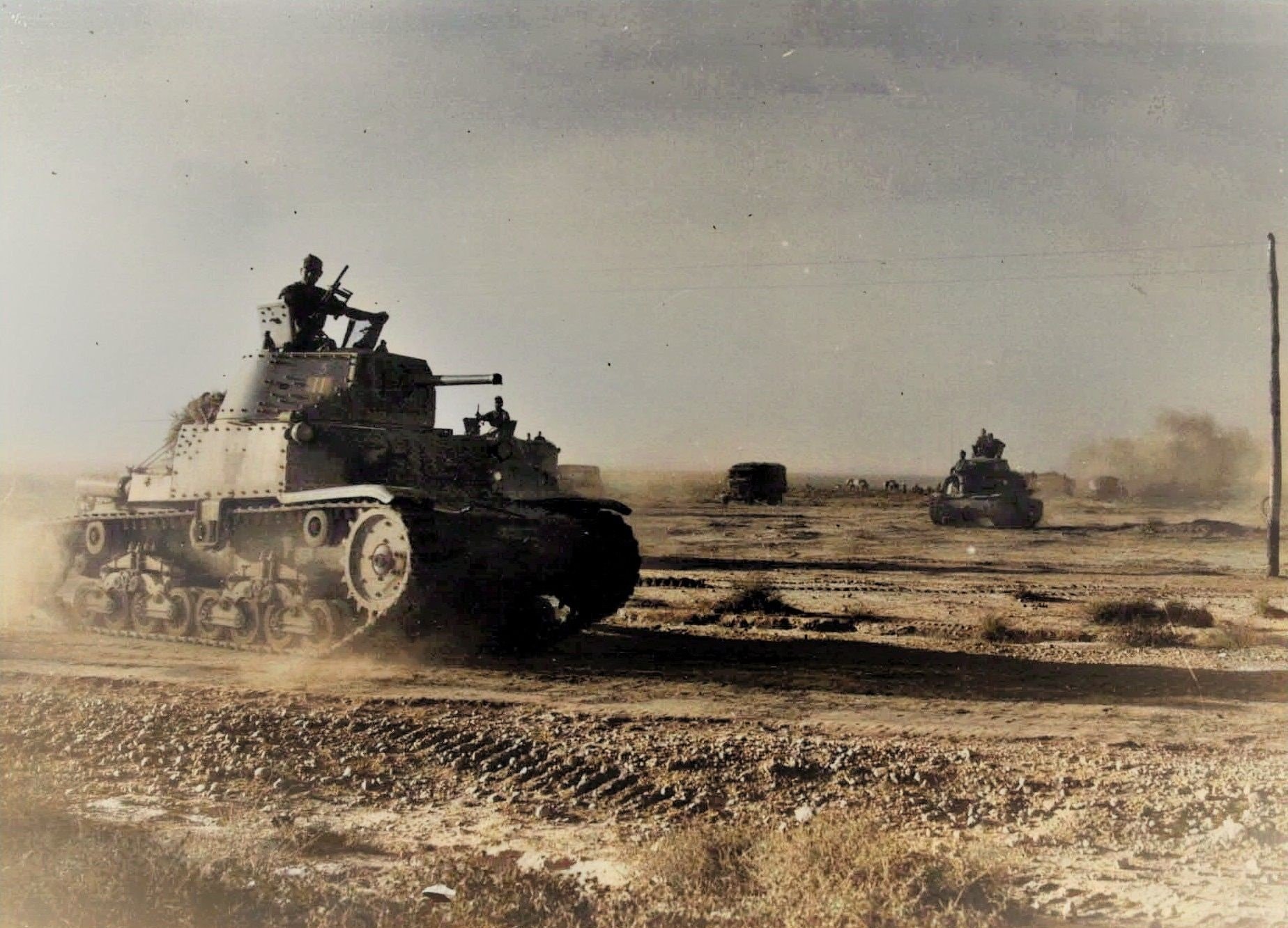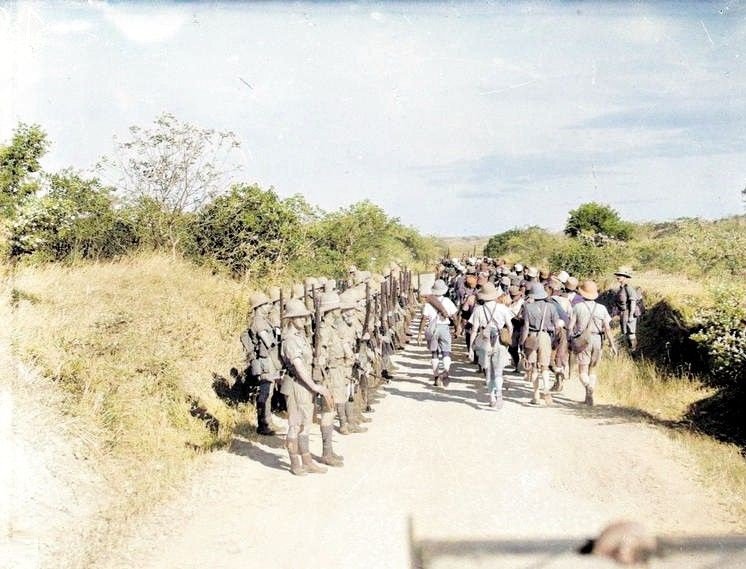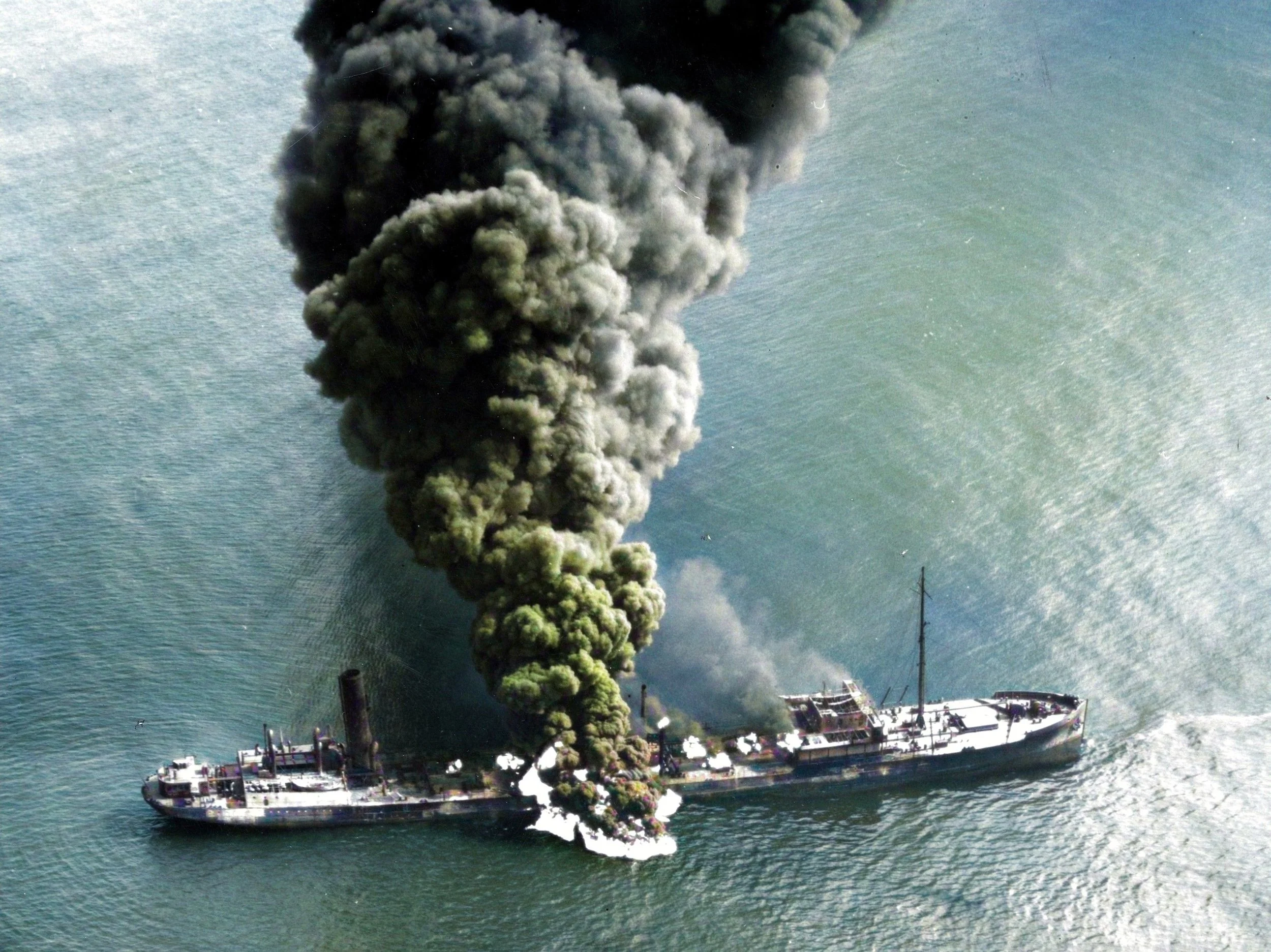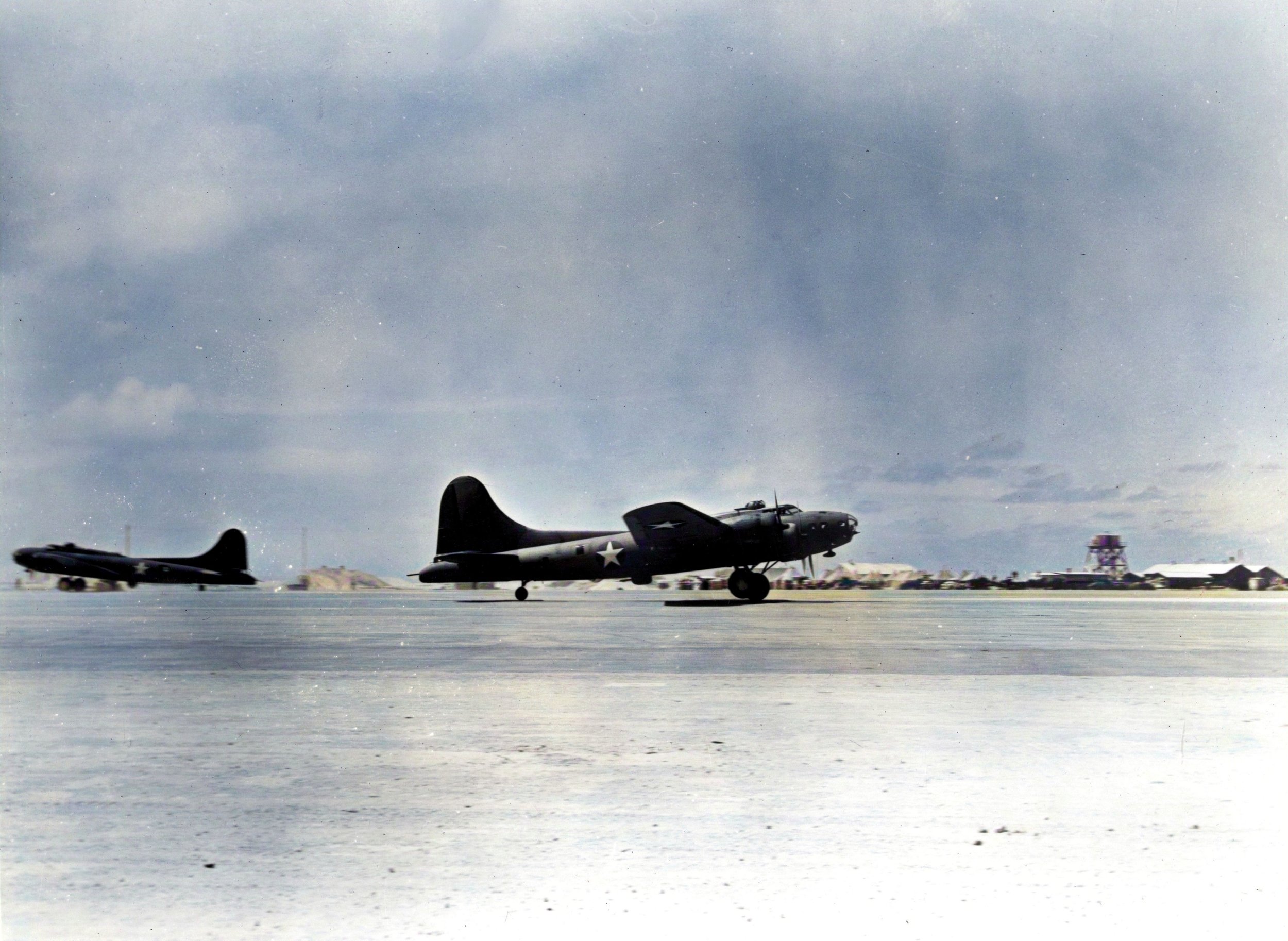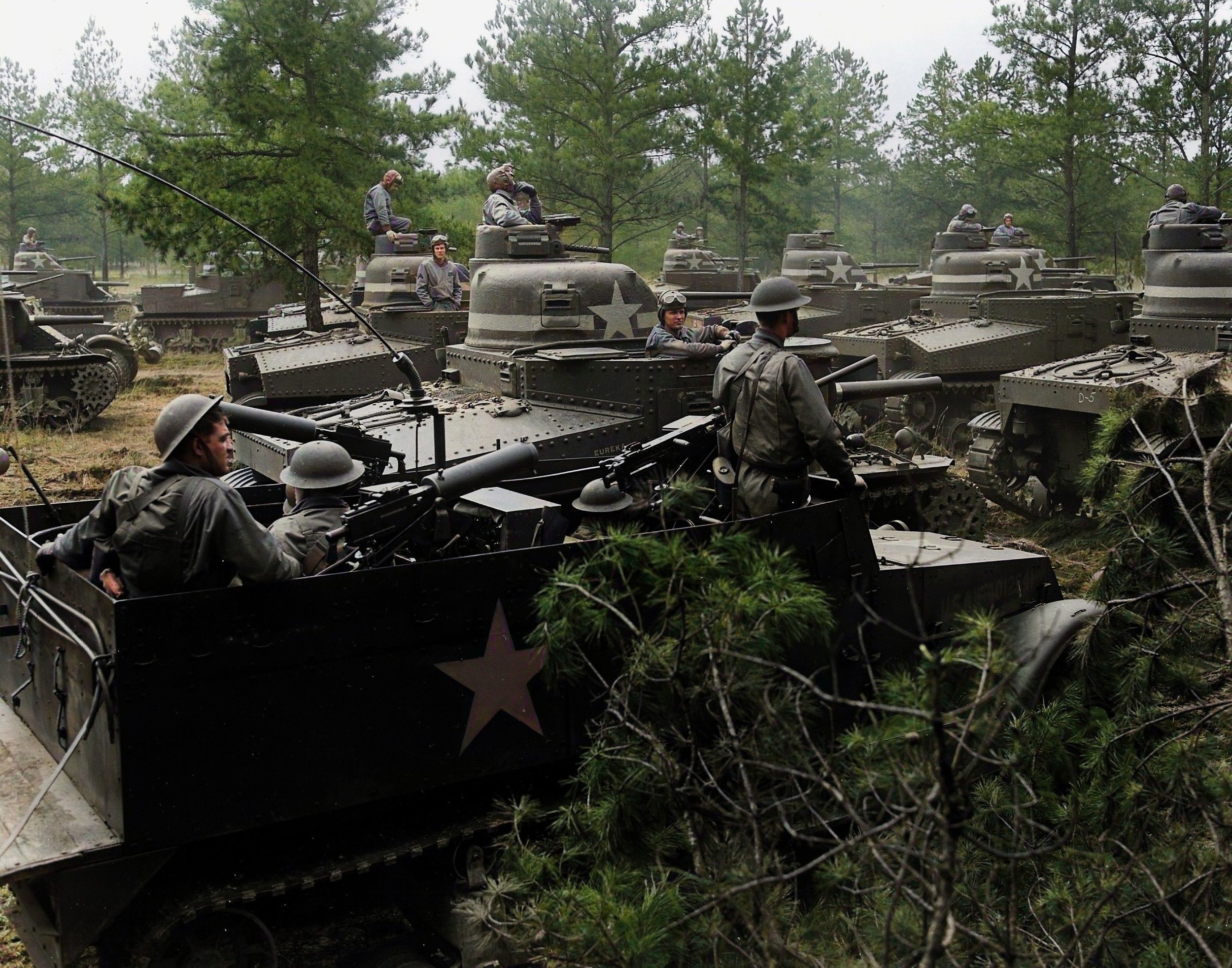Spring, 1942
Chapter 16
The Germans Resume the Offensive
April-June
The beginning of 1942 had been one of setbacks for the Allies on all fronts. The Japanese Empire has thus far seemed nearly unstoppable, with its fleets owning the Pacific while its armies conquer most of Southeast Asia as well as the islands of the Pacific. In the deserts of North Africa Rommel and his Afrika Korps have been pushing the British back toward Egypt, and the winter reprieve on the Eastern Front is soon to end.
Europe: The Eastern Front
Soviet sailors in Leningrad
Russian International News Service
The temporary reprieve enjoyed on the Eastern Front since the end of the Battle of Moscow was soon to end as spring neared. Around the besieged former Romanov Capitol, the Germans were able to push back the meager Soviet gains, rescuing several pockets isolated by the attempted counteroffensives by the Leningrad Front. The Germans were, however, still unable to break into the city center, and were by the end of June awaiting the arrival of heavy railway guns to apply more pressure yet on the starving but still defiant city.
General Erich von Manstein observes his troops near Kerch
The main German offensive for 1942 was to be focused further south. With the failure of operations around Moscow, the OKW (German High Command) had realized that the USSR would not fall quickly, and in the resulting war of attrittion it would be critically important that the oil fields of the Caucasus be captured both to deprive the Red Army of this resource and to satiate the fuel thirsty German wat machine. This moved the focus of operations toward Ukraine, where the Soviets had managed to halt the advance of Operation Barbarossa at Rostov in the fall, and the fortress of Sevastopol in the Crimea continued to hold.
In late May the Germans launched their offensive around Kharkov, enveloping two Soviet Armies and destroying them before pushing deeper into Soviet Russia itself. Bridgeheads across the Donets River followed in early June, and the main force of Fall Blau (Case Blue), the German summer offensive, commenced on 28 June, with two Army Groups and over 1.5 million men driving to the southwest.
The German Schwerer Gustav: the largest gun ever used in combat
In the Crimea, the Soviet foothold established by amphibious operations on the Kerch Peninsula in late 1941 had been subjected to increasing pressure ever since, and in mid May the pocket was destroyed by the Germans, allowing them to focus their full attention on Sevastopol. On 18 June the Germans took Fort Maxim Gorky, the last major defensive position outside the port. This installation, with its thick concrete emplacements and turrets similar to those on Soviet battleships, had proven a formidable obstacle, and its loss was a devastating blow.
As the outer defenses began to collapse, the Germans brought forward their massive siege artillery, including the enormous Schwerer Gustav: a monstrous 1,500 ton, 800mm (31inch) railway gun, the largest gun ever used in combat. The weapon required two lines of specialized parallel tracks to be laid for it to move, and could fire 10,000 pound shells almost thirty miles at a rate of fourteen shells per day. Supported by this massive ensemble of firepower, the Germans commenced their final attack into the city itself, with the lines to the north disintegrating. With a massive barrage of artillery and massed Luftwaffe bombers, the Germans pressed their attack into the streets on 30 June.
Europe: North Africa
Italian tanks attack the Gazala Line
The first three months of 1942 had not gone well for the British and their allies in the North African desert. Rommel and his Afrika Korps had pushed them back to the Gazala Line, extending along the border of Egypt to a small salient into Libya along the Mediterranean coast. Both sides had stopped to regroup and collect themselves, but it was Rommel who struck first on 26 May, with his forces smashing into the Gazala Line.
Taking cover behind a knocked out Panzer III, the commander of a British Stuart light tank checks for additional enemy
The main force hitting the line was actually Italian, with the Afrika Korps moving to flank the British in the night. Heavy resistance to this maneuver was encountered around Bir Hakeim, and this would force Rommel to halt the panzer advance to eliminate this threat after three days. Defended by Free French and British Indian troops, Bir Hakeim boasted a collection of entrenched anti-tank weapons in addition to determined troops, and initial attacks by Italian tanks had been costly failures. The fighting here would continue for over two weeks, until the position was finally overrun on 11 June.
A battery of German 88mm guns in action
German Federal Archives
As the fighting for Bir Hakeim continued, the British moved to take advantage of the gap in the Axis forces created by movements to crush the pocket. This movement, Operation Aberdeen, saw the British 8th Army moving out in force, but they were met with accurate long range fire from the German 88mm flak guns, as well as determined resistance. By 13 June the situation had collapsed, with large quantities of British tanks destroyed and the 8th Army in retreat and nearly enveloped, escaping with only 70 of its original complement of 300 tanks.
Mussolini inspects German troops
German Federal Archives
As the German advance continued, Barida fell on 17 June, again isolating the Allied defenders in the port of Tobruk, and struck toward the city the next day. After clearing the last defenses of the perimeter, the Germans and Italians attacked Tobruk itself on 20 June, with the city falling the next day. The port was full of Allied supplies that had been brought in to support future operations, and now the Germans were poised to pursue the Allies into Egypt. The fall of Cairo and the Suez Canal would be a disaster for the British, potentially cutting the two far distant theaters of war separated by the vastness of the African continent.
The new British line in Egypt was attacked on 27 June, and was breached the next day, seeing the British retreat further still toward Cairo. In recognition for this success, Hitler promoted Rommel to the rank of Field Marshal, and Mussolini flew to Libya to inspect troops and prepare to lead a triumphal entry into Cairo.
Europe: Africa
Captured Vichy French soldiers are marched past British troops in Madagascar
The Central African Theater reopened on 5 May, when British forces landed in Vichy French Madagascar. The island possessed an excellent deep water port at Diego Garcia, and with the Imperial Japanese Navy pushing into the Indian Ocean there was much fear among the Allies that the Vichy French government there may allow the Japanese the use of the island, in a repeat of what had occurred in Indochina in 1940.
The landings were opposed by the Vichy garrison there, with strict orders from Admiral Darlan (the effective head of the Vichy Armed Forces) to fight to the end. The British were nonetheless able to break through the lines, and Diego Suarez fell on 7 May. Assistance was requested from the Japanese, who dispatched four submarines to the island but were unable to offer further support. Following the fall of Diego Suarez the campaign slowed down, as the Allies rotated units back to more important fronts, and desperate requests for reinforcement by the Vichy defenders were unable to be realized by the government in France.
Europe: The War at Sea
The tanker SS Byron D. Benson sinks after being torpedoed by a U-boat
Across the cold expanse of the Atlantic, the Kriegsmarine continued its unrelenting U-boat campaign along the US Eastern Seaboard. Merchant ships were being torpedoed at an alarming rate, and it was not until 14 April that the US Navy achieved its first confirmed kill on a German submarine. Not long after, the commander of the US convoy escort command, Admiral Arthur Bristol, died of a heart attack, further complicating the American response to this threat.
A Giussano class light cruiser of the Regia Marina
Back across the sea, the war continued as well. In the North Sea the Kriegsmarine’s surface fleet was making small movements, including striking at convoys heading to the Soviet Union with destroyers. In the Mediterranean the Regia Marina was also active, sinking several Royal Navy ships across the theater, taking advantage of the superiority gained after their actions in late 1941.
Europe: The Air War
Civilians pass down a ruined street in Valletta on Malta
In the skies over Europe, the Luftwaffe had commenced an operation over Leningrad aimed at the destruction of the Soviet Baltic Fleet at Kronstadt. Despite huge numbers of planes attacking the ships, none were lost, and this the big guns of the fleet remained available for the defense of the besieged city.
Far to the south, the Regia Aeronautica and the Luftwaffe continued to hammer the island of Malta. Efforts by the RAF to reinforce the defense with modern Spitfire fighters was met with mixed results, as the raids destroyed the first batch of planes on the ground immediately after their arrival. The destruction wrought upon the city of Valletta was significant, as was that upon the city of Exeter in Britain, as the Germans commenced another round of “Blitz” raids on British cities.
RAF ground crews load a 4,000 pound bomb onto a Wellington medium bomber
Even as the Luftwaffe resumed its strategic bombing campaign on Britain, the RAF continued to escalate its night bombing offensive against Germany. 1,000 bombers struck the city of Cologne at the end of May, causing significant damage, with the nightly phenomenon of sirens and bombs becoming the norm now for the civilian population on both sides of the European conflict.
Europe: Occupied Europe
Pierre Laval (right) with Petain and other Vichy officials
Across the vast expanse of Occupied Europe, various political developments were afoot. In France the Germans were tightening their grip on the nominally independent Vichy Government. Petain’s show trial in Riom of former Republican officials had developed into a massive political embarrassment, prompting Hitler to force its closure. The Fuhrer had also pressured Vichy to restore Pierre Laval to office, after his removal for overstepping his authority in his efforts to kowtow to the Germans.
In another notable story, French General Henri Giraud, who had been held as a prisoner of war in a German castle since the Fall of France, escaped using a rope made from bedsheets and managed to make his way across Germany to neutral Switzerland, and from there was able to make it back to France, where he was able to live under Petain’s protection.
The most significant event, however, would take place in Czechoslovakia, or as the Germans now referred to it, the Protectorate of Bohemia and Moravia. The territory was nominally overseen by Reichsprotektor Konstantin von Neurath, but as he was considered to be too lenient on the Czech population, the brutal SS Obergruppenfuhrer (General) Reinhard Heydrich had been appointed as his deputy, and was the real leader of the territory.
Reinhard Heydrich
German Federal Archives
An operation had been in the works by the intelligence service of the Czech Exile Government since Heydrich had taken the position, and in late 1941, with the backing of the British Special Operations Executive (SOE), a group of nine agents were inserted into the country via parachute. The two leaders, Jozef Gabčík and Jan Kubiš then contacted local resistance groups and began to prepare for their attack, waiting several months.
On 27 May of 1942 the assassins positioned themselves along a tight corner on the route taken by Heydrich every day on his way to his office in Prauge. Here the large Mercedes would need to slow down, and as it did so pulled out a British Sten submachine gun he had concealed under a long coat and attempted to fire, but the gun jammed. Heydrich, rather than ordering his driver to speed up and get out of danger, ordered the car to halt as he drew his sidearm to kill the would be assassin, allowing Kubiš to throw an anti-tank grenade into the car, badly wounding Heydrich. The assassins then fled, unaware that Heydrich (who had continued to fire and pursue them on foot for a short distance, had been wounded at all.
Reinhard Heydrich’s car after Operation Anthopoid
Despite medical treatment and apparent recovery, Heydrich died on 4 June, leading to the Germans instigating a series of brutal reprisals for the assassination of such a high profile figure. Five thousand Czech civilians were executed, and more than double that number were sent to concentration camps. The villages of Lidice and Ležáky were both razed by the SS, and their inhabitants slaughtered or sent to the camps. As for the assassins, they were cornered in a Prague church after being sold out by a resistance fighter, and besieged by 750 SS troops. All were either killed or committed suicide.
Pacific: Pacific Islands
Japanese troops land on Kiska, one of Alaska’s Aleutian Islands
On the islands of the Pacific, the Japanese continued their seemingly unstoppable march of conquest. The US holdouts on Bataan in the Philippines collapsed in early April, followed a month afterward by the headquarters on Corregidor, representing the last of the major Japanese objective from the opening of the Pacific War to be accomplished. The Japanese concurrently secured Bougainville Island, as well as the Solomons, and in early June landed in the Aleutian Islands of Alaska, representing a Japanese foothold in North America.
Pacific: Southeast Asia
The Yenangyaung Oil Fields in Burma burn after the British retreat
In Burma the Japanese continued to push back the British. Bombers caused a firestorm in Mandalay in early April, and by the end of the month the Japanese had taken the vitally important Yenangyaung oil fields, despite the British destroying them as they withdrew. A Chinese counterattack was launched in the area, but succeeded only in stalling the Japanese advance toward India. By early May the Japanese had taken Mandalay, and by the end of the month had crossed into China and engaged the British along the Indian border. The onset of the monsoon season served better to halt the Japanese than had any military efforts thus far, buying some respite for the beleaguered British forces.
Pacific: China
Chinese troops in action along the Great Wall at Xifengkou Pass
In late May of 1942 the Japanese launched a series of offensives in China, aimed at destroying China’s air power and punishing the population for supporting the Doolittle Raid. This operation, codenamed Operation Sei-Go, was accompanied by acts of utter barbarity as the Imperial Japanese Army destroyed entire villages and slaughtered 250,000 Chinese civilians suspected of aiding the Doolittle fliers. In addition, the Japanese deployed Unit 731, the so-called “Epidemic Prevention and Water Purification Unit of the Kwantung Army” to support the operation. This secretive unit, headed by General Shiro Ishii, was in reality a biological weapons research unit, and they used the offensive as an opportunity to test various deployment methods for bubonic plague, typhus, cholera and more, generally deployed via distributing contaminated food to the starving civilians along their axis of advance. By the end of June the Japanese advance was still continuing, as the Chinese were pushed back across the front and the Japanese pushed further into Southeastern China.
Pacific: Naval War
HMS Hermes sinks in the Indian Ocean after being attacked by Japanese carrier planes
At sea, the Imperial Japanese Navy had penetrated into the Indian Ocean at the end of April, and their carriers commenced a series of attacks on British ships and assets in the area before withdrawing on 10 April. During this time they were able to sink two Royal Navy cruisers as well as the carrier HMS Hermes, along with several other ships, along with damaging port facilities. In exchange, the Japanese lost a handful of planes, the ships managing to evade the Royal Navy’s attempts to bring them to battle.
SBD Dauntless Dive Bombers fly past the USS Yorktown in the Coral Sea
A month later, however, the Allies were able to bring the Japanese to battle for the first time, as both fleets clashed at the Coral Sea. The Japanese, having made advances and secured the island of Tulagi as well as expanding their hold in New Guinea, intended to destroy the American naval presence in the area after aircraft from the carrier USS Yorktown had interfered with the Tulagi operation.
The Japanese spotted Task Force 17, the US carrier group under Admiral Jack Fletcher, on 6 May as they refueled, but due to both the distance to the target and incoming bad weather deceided not to strike until the following day. US Army Air Force bombers attacking Port Moresby from Australia likewise spotted and reported the Japanese fleet that day, leaving the stage set for a confrontation on 7 May. The IJN mustered two fleet carriers; Shokaku and Zuikaku, as well as the light carrier Shoho. Opposing them were the fleet carriers USS Yorktown and USS Lexington.
On 7 May both forces launched scout flights to locate the enemy fleets, and both reported contacting enemy vessels at around the same time. The Americans had found a convoy of troopships escorted by the Shoho, and after a report was sent to Fletcher mistakenly identifying it as the main carrier force the Admiral launched all his aircraft to strike it. The Japanese made a similar mistake, sending their entire force against a small group of cruisers, sinking a destroyer along with an oiler. On the other side, the Americans fell upon the Shoho, tearing it apart with a total of thirteen bombs and two torpedo hits.
USS Lexington explodes
The battle continued the next day, and again both sides spotted each other almost simultaneously. This time both had also found the main enemy force, and raced to launch their strikes as quickly as possible. The Americans reached the target first, with Dauntless dive bombers and Devastator torpedo bombers attacking the Japanese carriers and hitting Shokaku with several bombs. These hits penetrated the deck and detonated aviation fuel tanks, and the blazing carrier was forced to withdraw as the Americans turned back for home.
The Japanese began their attack about an hour after the US began their strike, managing to hit Lexington with torpedoes, although Yorktown was missed. One of these hits damaged the aviation fuel tanks, leading to a spreading of vapors throughout the ship. A subsequent attack by Val dive bombers managed to damage Yorktown and cripple Lexington before the Japanese withdrew. In total, the US had sunk one Japanese light carrier and badly damaged a fleet carrier, while one US fleet carrier was damaged and another was sunk, Lexington having succumbed to her wounds when the almost-controlled fires detonated the fuel tanks, forcing the crew to abandon ship.
The Battle of the Coral Sea had ended essentially in a draw, with the Japanese prevented from landing at Port Moresby, while the US lost one carrier and had another badly damaged. It also heralded a new age of naval warfare, as for the first time in history neither side’s ships had ever actually contacted each other, instead fighting over the horizon with carrier aircraft.
Pacific: The Air War
A B25 Mitchell takes off from the USS Hornet for the Doolittle Raid
In the skies over the Pacific Theater, another major development had taken place in mid April. Sixteen US Army Air Force B25 medium bombers had launched an attack from the carrier USS Hornet just east of the Japanese Islands and successfully bombed Tokyo along with other industrial targets. This daring raid, organized in the utmost secrecy and undertaken by a group of volunteer pilots under the command of the famous racing pilot and US Army officer Jimmy Doolittle, represented the first enemy strike on Japan itself. This action served to buoy the morale of the Allies, as well as to shock the people of Japan. As the bombers proceeded to land in China, the IJA launched massive offensives to punish the local Chinese as well as locate the aviators, but in the end only captured eight, of which three would be executed.
US Army Air Force B17 bombers arrive on Midway Island
Meanwhile, something was brewing in the central Pacific. US Naval Intelligence had intercepted Japanese transmissions that a major operation was planned for a target labeled as “AF”, and the American cryptanalysts under Commander Joseph Rochefort set to identifying this target. Confirmation came when Rochefort instructed the commander of the garrison at Midway Island to send an uncoded emergency message that their water desalination plant had broken down, prompting the Japanese to report that “AF” was out of water. Thus aware, Admiral Nimitz began to reinforce the island, with Army bombers being redeployed there as well as the two remaining preparing the three remaining carriers, USS Enterprise, USS Hornet and USS Yorktown (still under repair after the Coral Sea) to prepare to ambush the Japanese fleet.
The Homefront
George Dasch, one of the German spies landed in the United States, after his capture
At home, the Germans made their first moves against the United States, as U-boats landed agents in Ney York and Florida as part of Operation Pastorius. The operation called for the agents to sabotage various powerplants, industrial sites and infrastructure, as well as terror bombings of civilian areas. After being confronted by a Coast Guardsman on patrol, the agents in New York fled, and even though they managed to avoid the manhunt that followed the plan fell apart shortly afterward. One member, George Dasch, who had served in the US Army in the interwar years after moving to the country (returning to Germany in 1938), defected and contacted the FBI, turning in the entire group of eight agents.
Political Developments
New US troops and vehicles at a base in the United States
In the United States the massive rearmament program that had kicked off after Pearl Harbor would soon be ready to begin deployments, both to counter the Japanese in the Pacific as well as to enter the fray in Europe. In late June Churchill again found himself in Washington, meeting with Roosevelt concerning just what to do with this growing force. To this end, the decision was made to commit US troops to an invasion of North Africa via Vichy French Tunisia, in order to open a second front in the desert and take the pressure off the British in Egypt. Soon the Americans would be fully deployed, as the Axis continued their seemingly unstoppable advance on all fronts.
Timeline
4-2-1942
The American freighter David Atwater is sunk off the US East Coast by a U-boat with gunfire, killing many of the crew
4-3-1942
Japanese bombers strike Mandalay in Burma, causing a firestorm
4-4-1942
The Luftwaffe launches a major strike on the Soviet naval base at Kronstadt
4-5-1942
Japanese forces secure Bougainville Island
Japanese carrier planes in the Indian Ocean strike at Royal Navy facilities in Ceylon, sinking two British heavy cruisers
4-7-1942
A massive air raid is launched by the Luftwaffe and Regia Aeronautica against Malta
4-9-1942
Bataan falls to the Japanese
The British carrier HMS Hermes is sunk with some of her escorts of Ceylon by Japanese carrier planes
4-10-1942
The Japanese fleet withdraws from the Indian ocean
4-11-1942
A German U-Boat sinks the tanker Gulfamerica off the Florida coast, so close that the captain maneuvers to avoid hitting Jacksonville with missed shots
Japanese forces in Burma begin an offensive toward the Yenangyaung oil fields
4-12-1942
The first Hungarian units begin to ship out for the Eastern Front
4-13-1942
An RAF fighter accidentally strafes a crowd of civilians during a demonstration flight, killing 25 and injuring many more
4-14-1942
The US Navy sinks its first U-boat of the war off Cape Hatteras
Pierre Laval, who had been removed for overstepping his authority in catering to the Germans, is named Prime Minister by the Vichy government after significant pressure.
4-15-1942
The disastrous Riom Trial in Vichy France is ended by order of Hitler with no conclusion
King George VI awards the George Cross to the besieged island of Malta
4-17-1942
In Burma, Yenangyuang and its il fields fall to the Japanese, although the retreating British had destroyed the infrastructure before withdrawing
4-18-1942
As the mud season begins, the Eastern Front stagnates
The Doolittle Raid takes place, with US bombers striking Tokyo and surrounding cities after launching from the carrier USS Hornet
4-19-1942
Chinese forces launching a counterattack near Yenangyuang rescue an Indian force, stalling the Japanese advance
4-20-1942
RAF Spitfire fighters are transferred to Malta, but are destroyed on the ground within minutes of landing as a German raid hits the airfield
4-21-1942
British and Canadian commandos raid the French town of Hardelot in a reconnaissance mission
Ace fighter pilot Edward “Butch” O’Hare receives the first US Navy Medal of Honor of the war
4-23-1942
The British city of Exeter is his by a major German air raid, signalling the start of a new strategic bombing campaign that would become known as the Baedecker Blitz
4-25-1942
French General Henri Geraud makes a daring escape from his imprisonment at a German castle, eventually making his way back to Vichy France. He would remain there under the protection of Petain, despite his true loyalty being to the Allies.
US troops land on the Free French island of New Caledonia near Australia to reinforce the garrison there
4-26-1942
The Reichstag meets for what is to be the last time, authorizing Hitler to execute or pardon anyone he wished with no interference from the courts.
4-27-1942
All Dutch Jews are mandated to begin wearing the Star of David badge by the German authorities
Japanese troops take Lungyu in China
Admiral Arthur Bristol, commander of the US Navy carrier escort force in the Atlantic, dies of a heart attack
4-28-1942
Japanese troops take Chinlan in China
Parts of the US East Coast initiate blackout policies
4-29-1942
The Japanese take Lashio in Burma, cutting off Mandalay from Chinese reinforcement
Hitler and Mussolini meet in Strasbourg for a strategy conference
Several prominent US actors and musicians commence a tour to raise money for the war effort
4-30-1942
Soviet offensive operations near Leningrad come to an end with no results
1,000 Jews are murdered by the SS at Zdzięcioł in Occupied Poland
5-1-1942
British troops evacuate Mandalay in Burma
5-2-1942
Three German destroyers attack and sink a British cruiser off the Norwegian coast
Japanese troops sieze Mandalay
Jose Santos, the Chief Justice of the Philippine Supreme Court and the man appointed as Acting President by Quezon when he left, is executed by the Japanese
5-3-1942
The Prime Minister of Occupied Denmark, Thorvald Stauning, dies
Japanese troops land on the island of Tulagi
5-4-1942
Tulagi and the rest of the Solomon Islands are secured by the Japanese
The first major naval battle of the Pacific War begins when US and Japanese carrier fleets clash in the Coral Sea
5-5-1942
British forces invade Vichy French Madagascar, encountering only light resistance as they advance on the port of Diego-Suarez
Japanese troops land on Corregidor in the Philippines
Japanese forces in Burma cross the Chinese border
5-6-1942
Corregidor falls to the Japanese, with General Wainwright forced to order the surrender of all US forces in the Philippines
5-7-1942
Diego-Suarez in Madagascar falls to the British
The Japanese carrier Shoho is sunk by US carrier planes in the Battle of the Coral Sea
5-8-1942
The carrier USS Lexington is scuttled in the Coral Sea after taking heavy damage, as the Battle of the Coral Sea ends inconclusively.
5-10-1942
RAF Spitfires are again transferred to Malta, and this time avoid destruction on the ground
Churchill pledges that if the Germans deploy gas against the Soviets the British will also begin to use it against the Germans
5-12-1942
The Germans launch an offensive against the Red Army at Kharkov in Ukraine
5-14-1942
British forces in Burma are pushed back to the Indian border
US Naval Intelligence intercepts a Japanese plan to attack Midway Island
5-15-1942
The US Women’s Amy Auxiliary Corps (WAAC) is formed
Gasoline rationing begins in the United States
5-19-1942
The last Soviet forces are pushed off the Kerch Peninsula
5-20-1942
German forces releive another pocket near Leningrad
5-22-1942
Black American troops mutiny after racist incidents in Australia, with Australian troops being called in to suppress them
After several of its ships are sunk by submarines, Mexico declares war on Japan and Germany
5-23-1942
Near Kharkov, the Germans envelop two Soviet field armies
5-26-1942
Rommel launches a new offensive in North Africa, attacking Gazala and Bir Hakeim
5-27-1942
British backed Czech commandos ambush Reichskommisar Reinhard Heydrich, inflicting serious injuries
Jews in Occupied Belgium are ordered to begin wearing the Yellow Star Badge
5-28-1942
The Germans destroy the encircled Soviet forces near Kharkov, inflicting over a quarter million casualties on the Red Army
5-29-1942
German contingency plans for the occupation of Vichy France are revised
The Jews of Paris are ordered to begin wearing the Yellow Star Badge
5-30-1942
1,000 RAF bombers hit Cologne in Germany
5-31-1942
Japanese midget submarines attack Sydney Harbor in Australia
6-2-1942
The Germans commence a massive barrage on the besieged city of Sevastopol, including the Schwerer Gustav railway cannon, the largest gun ever used in combat
6-3-1942
Japanese carrier planes attack Dutch Harbor and the US Army base at Fort Mears in Alaska
The British government nationalizes coal and dairy industries
6-4-1942
The US Navy ambushes the Japanese fleet heading to Midway Atoll, with American carrier planes sinking three Japanese carriers
Reinhard Heydrich dies of his wounds
6-5-1942
The British attempt a counterattack to destroy the German salient at Gazala
A fourth Japanese carrier, damaged yesterday, sinks at Midway. Admiral Tamon Yamahuchi goes down with his ship
6-6-1942
Japanese troops invade the Aleutian Islands of Alaska
The Japanese cruiser Mikuma is sunk off Midway
6-7-1942
The carrier USS Yorktown succumbs to her wounds and sinks at Midway
The Battle of Midway ends in a crushing American victory
6-8-1942
A Japanese submarine bombards Newcastle in Australia
6-9-1942
RAF planes attack the Regia Marina base at Taranto
6-10-1942
German forces in the Kharkov sector cross the Donets River
The SS razes the village of Lidice in Czechoslovakia to the ground, executing almost all inhabitants in retaliation for the assasination of Reinhard Heydrich
6-11-1942
Bir Hakeim falls to the Germans as the British retreat
Lt. Michael Kitzleman of the German Wehrmacht is executed for speaking out about atrocities committed in Russia
6-12-1942
German forces at Gazala defeat the British counterattacks and envelop them
Four German spies are landed by U-boat on the US East Coast near New York City
6-13-1942
British forces abandon the collapsing Gazala Line
The US Government forms the Office of Strategic Services (OSS)
6-14-1942
British forces north of Gazala retreat before the Germans can cut them off at the coast
6-15-1942
German forces in Libya reach Sidi Rezegh
Several Royal Navy ships are sunk or disabled across the Mediterranean
6-17-1942
German forces retake Barida, again isolating Tobruk
Japanese Prime Minister Hideki Tojo survives an assassination attempt in Tokyo
6-18-1942
The Germans capture the last major fortification on the Sevastopol perimeter
The assassins of Reinhard Heydrich are cornered by the Germans, and kill themselves after a fierce gun battle
German spies are landed in Florida by U-boat
Churchill travels to Washington for conferences with Roosevelt
6-19-1942
A German plane crashes over Soviet lines, with one of the officers carrying the planes for the upcoming summer offensives. Stalin and the NKVD dismiss them as a plant
6-20-1942
A Japanese submarine attempts to shell a lighthouse in British Columbia, with no effect
Churchill and Roosevelt agree to deploy US forces into North Africa
6-21-1942
Tobruk falls to the Germans
A Japanese submarine shells the US Army Base Fort Stevens in Oregon
6-22-1942
Rommel is promoted to Field Marshal after his victory at Gazala
6-23-1942
An accident occurs in the German nuclear weapons program, causing an explosion. Some Allied intelligence reports mistake this as an actual nuclear test, while in reality it is a severe setback
6-24-1942
German and Italian forces enter Egypt
General Dwight D. Eisenhower takes command of US forces in the European Theater
6-25-1942
Claude Auchinleck takes command of the British 8th Army in North Africa
6-26-1942
German forces commence their attack on the center of Sevastopol
6-27-1942
The Germans engage the British at their new line in Egypt
The FBI announces the capture of the eight German spies landed on the East Coast
The White Rose Movement of passive resistance to the Nazi Government begins in Germany
6-28-1942
The Germans launch their summer offensive on the Eastern Front, concentrated at Voronezh
6-29-1942
The British line in Egypt collapses
Mussolini flies to Africa to lead a victory parade into Cairo


